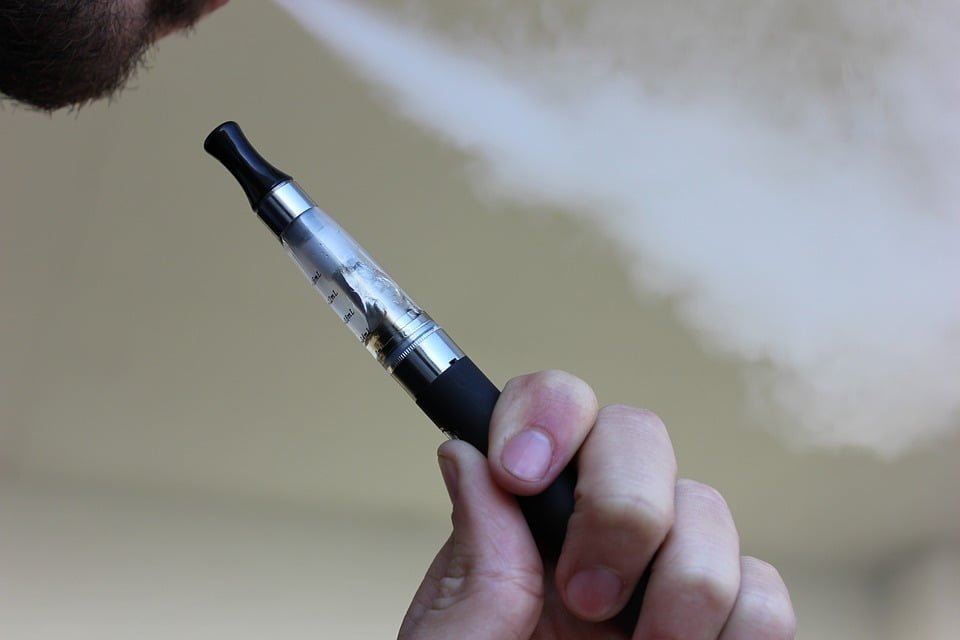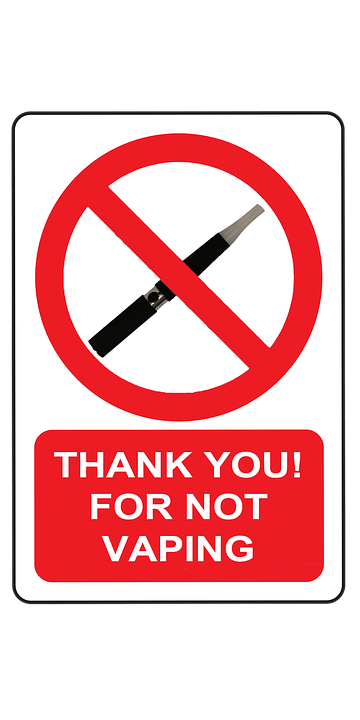EVALI (e-Vaping Associated Lung Injury) is a serious and life-threatening lung condition that affects people who use electronic cigarettes. It primarily affects the lungs and results in sudden respiratory failure.
Vaping:
Vaping refers to inhaling the vapors that are produced by vaping devices such as electronic cigarettes.
Electronic cigarettes:
An E-cigarette (electronic cigarette) is a vaping device that works by a battery-powered system that produces smoke.
E-cigarettes are also called by different names, such as mods, tanks, e-hookahs, and vape pens.

Composition of liquid in e-cigarettes:
The liquid in e-cigarettes is heated, which is then converted to smoke or vapors that are inhaled. These devices have cartridges that are filled with that liquid.
The liquid is a mixture of tetrahydrocannabinol (THC) oils, cannabinoid (CBD) oil, vitamin E and A, coconut oil, different flavors, and obviously nicotine.
Several synthetic flavors are added to enhance the whole experience. The ENDS (Electronic Nicotine Delivery Systems) is the main functioning unit of an e-cigarette that has humectants such as propylene glycol (PG) and vegetable glycerin (VG) to produce vaping.
Mechanism of E-cigarettes:
The e-cigarettes work by heating that liquid mixture, which is mostly based on propylene glycol and glycerol, along with flavor, and nicotine. Hence, heating that liquid mixture produces smoke or vapor.
Disadvantages of using e-cigarettes:
The following are the disadvantages of e-cigarettes:
Addiction:
Addiction is developed from using e-cigarettes. However, it’s not important to use vapes or e-cigarettes every day to develop an addiction.
Moreover, the addition of e-cigarettes can lead to other addictions in the future. The addiction to e-cigarettes turns out to be very bad and hard to get rid of.
Therefore, people have to go through proper counseling or medications to get rid of this addiction.
Danger to the brain:
E-cigarettes hurt the brain because they have nicotine in them. Nicotine affects the focus of the brain, and it fails to perform basic functions, especially in kids and teenagers. It also affects mood as well as impulse control.
Poisonous:
The vapor or smoke produced from e-cigarettes contains toxic and harmful chemicals, which, when inhaled, cause toxicity and damage the lungs.
Effect on society:
Vaping e-cigarettes has a very bad impact on society. It is not just normalized and makes others addicted, but also, passively smoked e-cigarettes can be equally dangerous as direct vaping.

EVALI (E-Vaping Associated Lung Injury):
EVALI is an abbreviation for E-Vaping Associated Lung Injury. It is a medical condition in which the lungs of a person get seriously damaged due to the matter present in vaping products, such as e-cigarettes.
Symptoms of EVALI:
The possible symptoms of EVALI include:
- Shortness of breath (the most common symptom)
- Chest pain
- Fever
- Chills
- Night sweats
- Headaches
- Weakness
- Weight loss
- Cough
- Diarrhea
- Nausea
- Vomiting
- Abdominal pain
- Fast heartbeat
History of EVALI:
EVALI was first recognized in 2019. According to the reports from the Centers for Disease Control and Prevention (CDC), 2800 cases appeared in 2020, which included 68 deaths. Moreover, of those EVALI patients, 22% had asthma [Ref].
Patients of EVALI:
Patients with EVALI include 66% of males. Out of the 80% were under 35 years old in the age group of 13 to 85 years old. However, 16% were under 18 according to the reports from the Centers for Disease Control and Prevention (CDC).
Risk factors of EVALI:
The main risk factor of EVALI is the use of vaping. Particularly, the THC in the vapes. According to the Centers for Disease Control and Prevention (CDC), 80% of EVALI-diagnosed people were using vapes.
Moreover, the surprising fact was that all vape users had sourced the vapes from either illegal or informal resources, such as dealers, instead of buying them from official outlets.
Causes of EVALI:
Tetrahydrocannabinol (THC) is one of the most active ingredients of vape. THC has vitamin E acetate, which is a synthetic form of vitamin E, and studies suggest that it is the main component responsible for the damage to the lungs.
According to previous studies and research across 16 states, 48 out of 51 patients with EVALI had vitamin E acetate detected in their lungs.
Moreover, no such traces were found in the control group (people who do not vape). However, other chemicals present in nicotine and THC vapors are responsible for this condition, too.
Like, VEA acts as a carrier of drugs in the blood and the brain when inhaled. The propylene glycol (PG) and vegetable glycerin (VG) in ENDS effectively have acute effects on the respiratory system.
Generally, these are components of toxicity in e-cigarettes:
- Vitamin E Acetate (VEA)
- Humectants
- Flavorings such as vanillin, lemon-limonene, etc.
- Heating temperature
- Tetrahydrocannabinol (THC) oils
- Heavy metals such as arsenic, lead, etc.
VEA serves the purpose of a thickening agent in vaping devices like e-cigarettes. In EVALI, vitamin E is said to be the main culprit behind the toxicity.
As in a recent study of patients with EVALI, 48 out of 51 patients had vitamin E acetate in their lungs. Moreover, vitamin E acetate is not present in the healthy lungs of non-smokers.
The vitamin E acetate obstructs the lungs’ surfactants by coating up air sacs, which causes inflammation.
The high temperature of e-cigarettes converts vitamin E acetate into an irritating substance known as ketene that damages the lungs.
Humectants like propylene glycol PV, vegetable glycerin VG, or glycerol are used as additives in e-cigarettes to produce vapor. They cause inflammation of the lungs when inhaled.
There is a variety of flavors being used in e-cigarettes, and reportedly, most of them are not regulated by the Flavor and Extract Manufacturers Association (FEMA).
For example, diacetyl is a flavoring agent used in e-cigarettes that gives a buttery or creamy taste. It is reportedly causing a disease called popcorn lungs due to high levels of diacetyl being used to coat popcorn at factories.
Such kinds of flavorings are regulated by the Occupational Safety and Health Administration OSHA. Therefore, when diacetyl is used in e-cigarettes and users take three to four puffs, they exceed the exposure limits as per the Occupational Safety and Health Administration OSHA.
In e-cigarette liquids, the PG/VG, THC oils, and VEA are used to dilute nicotine. Upon heating this liquid at 500⁰F, various hydrocarbons and reactive aldehydes are formed, which are extremely toxic to the lungs.
For example, propylene glycol produces aldehydes when heated, which increases the exposure levels of carcinogens such as formaldehyde 15 times more, which is equal to a simple tobacco cigarette.
As the cartridges of e-cigarettes are refillable, their longer repetitive use leads to the decomposition of heating coils.
This produces a lot of heavy metals like arsenic, lead, zinc, etc., which are extremely toxic and cause serious lung injuries when inhaled.
When phospholipids and surfactants interact with the epithelial lining of the lungs, toxicity is produced. Moreover, abnormal lipid-laden macrophages related to lipoids and pneumonia are observed.
These components release the toxic particulate matter in the form of microns that later get deposited in the lungs.
These components deposit on the lungs and cause blackish spots on them and making them unhealthy.
Moreover, various other physiological changes in the functioning of the lungs are disturbed because of e-cigarettes, such as reduced pulmonary function.
In addition, some proteins like caspase-1 and apoptosis-associated proteins, promote cellular pyroptosis.
Airway lipid dysregulation and EVALI:
In EVALI, airway lipid dysregulation is observed. In airway lipid dysregulation, the epithelial lining fluid (ELF) or lung surfactants and their elements, like phospholipids, are said to have inflammatory responses towards the toxic components present in e-cigarettes.
Complexity and biomarkers of EVALI:
Due to increasing cases of EVALI and e-cigarettes being used as a trend, it is of dire need that biomarkers must be established to correlate the responses of EVALI to the use of e-cigarettes.
Various biomarkers, like lipidomic, genomic, epigenetic, etc, have shown promising results as biomarkers for lung injuries, so there is a high possibility of doing the same for understanding EVALI in e-cigarette users.
As the nature of e-cigarettes is highly heterogeneous and complex due to their varying formulations and nicotine levels, it’s even difficult to establish a perfect biomarker.
EVALI at the cellular and molecular level:
EVALI is a complex disease; to create an understanding of it, one has to dig deep at the cellular and molecular levels.
To maintain the homeostasis of the airway in the human body, several physiological mechanisms are involved, such as mucociliary clearance, phagocytosis of inhaled particles, lung surfactants, etc.
In the case of EVALI, the following airways are inherent in the immune cells and are the first responders when e-cigarettes are inhaled:
- Alveolar macrophages (AMs)
- The airway epithelial cells (AECs), like alveolar type I (AT-I) and type II (AT-II) cells
- The granulocytes or polymorphonuclear cells (PMNs)
The Alveolar macrophages (AMs) ingest or degrade the irritants, such as apoptotic cells, by ‘‘efferocytosis’’ that enter via e-cigarettes.
The AMs are the phagocytes that help in reducing inflammation and preventing damage to the tissues of the lungs.
However, the use of excessive e-cigarettes suppresses this activity, which leads to failure in controlling the inflammation of the lungs. However, the AECs and PMNs contribute to lung injuries in response to inhaled irritants.
EVALI diagnosis:
Generally, there is no specific test for EVALI. Diagnosis of EVALI is a complex task due to its common symptoms with other respiratory diseases, such as seasonal flu, pneumonia, etc.
Most doctors make a precise decision by ruling out the symptoms of other respiratory disorders. Moreover, the patient’s history is used to diagnose EVALI, as a person who has EVALI has a history of using e-cigarettes or vapes.
Moreover, e-cigarettes also cause other respiratory issues like transient lung inflammation and gas exchange dysregulation, which makes the diagnosis of EVALI a tougher task.
Direct examination of the lungs, called bronchoscopy, is a very challenging task to be performed for this purpose, as the patient’s body is too weak to withstand the process of bronchoscopy.
The worst part is that even the patients with EVALI who went through bronchoscopy have failed to identify the mechanisms of EVALI and its destruction done to the lungs.
Medical examination for EVALI:
Medical examination by the doctors for EVALI starts with the use of a stethoscope to listen to the lungs.
Heart rate is observed. Blood oxygen saturation levels are observed. An X-ray of the chest is also required.
CT scan of the chest is also carried out; it is a very important step because it shows the opacities in the lungs, which are basically the hazy spots on the lungs. These spots indicate unhealthy lungs, and spot-free space indicates healthy lungs. Sometimes, doctors advise blood tests, too.
Tracing causative agents of EVALI in patients:
Tracing causative agents of EVALI in patients is a difficult task because of the variety in e-cigarette formulations.
E-cigarettes are mostly sourced illegally by dealers. Therefore, the toxins vary, and so do their adverse effects on the lungs and the severity of EVALI.
Hence, systematic investigation is very important for the control and treatment of EVALI.
Treatment for EVALI:
EVALI is treated by pulmonologists. A pulmonologist is a doctor who deals with respiratory-related diseases. The following are the most common treatments for EVALI:
- Antibiotic and/or Antiviral
- Supportive care
- Corticosteroids
Antibiotic and/or Antiviral:
Antibiotics and/or antivirals are used to treat EVALI. This is because EVALI is very similar to bacterial or viral pneumonia. In both diseases, immunity and airways are affected.
There is cytotoxicity, which decreases the antimicrobial function of macrophages in the lungs. Therefore, antibiotics and antivirals help a lot in this aspect.
Moreover, they also help reduce inflammation. The antibiotic treatment should be according to antibiotic guidelines in the latest medical literature.
Supportive care:
EVALI patients are treated with supportive care, which includes supplemental oxygen through a nasal cannula, ventilator, an extracorporeal membrane oxygenation machine, neuromuscular blockade, prone positioning, etc.
In the case of ventilators, the patients are at risk of developing barotrauma, which is why it is recommended to use an end-expiratory pressure with a lower tidal volume.
Corticosteroids:
Corticosteroids are medicine that helps reduce inflammation of the lungs and other body parts. In the case of EVALI, corticosteroids contribute to treating the inflammatory response suppression.
However, there is no specificity for its doses, patterns, and duration, as it works based on the patient’s response to it and the severity of inflammation EVALI has caused.
It is preferred that the patient start taking corticosteroids from a lower to a higher dose. This helps prevent resistance against the medication by the body and from becoming habitual to its effect.
Corticosteroids are proven to work as a treatment for EVALI, as there are numerous studies in support.
Vaping and other diseases and their connection with EVALI:
Other than EVALI, vaping e-cigarettes is likely to cause pneumococcal infection because of the increased oxidative stress. The redox-active metals in the vapor are due to oxidation.
This leads to an increase in platelet-activating factor receptor (PAFR) expression. The pneumococcal infections are said to be a co-infection in EVALI patients.
The use of e-cigarettes also increases the risk of thrombogenesis. But EVALI patients do not go through thrombosis. Vaping also causes influenza. EVALI is a deadly combination of influenza and acute lung injury.
Outlook of people with EVALI:
There is no long-term data about EVALI patients’ reports, STS have bVALI as well.
Therefore, people do not take EVALI as a disease seriously. However, researchers are working hard to learn about this disease and provide people with more awakening data on EVALI.
Addiction to vape/e-cigarettes:
Vaping or using e-cigarettes can be very addictive. The more you use them, the more addictive they will become.
Due to nicotine present in them, the body and brain get used to it, and when one does not use e-cigarettes or vaping, the levels of nicotine in the blood decrease, and the body starts to crave it.
This craving is very discomforting and annoying, which influences the mind easily to take more nicotine. A person doesn’t have to vape or use e-cigarettes daily to develop an addiction.
Addiction can be developed even if people do not use vaping or e-cigarettes daily.
E-cigarettes without nicotine:
The majority of e-cigarettes have nicotine in them as the main ingredient, but nicotine-free e-cigarettes are also available.
These cigarettes have other chemicals that are used as an alternative to nicotine, but they are equally harmful. They can also damage the lungs.
Quitting E-cigarettes:
Quitting e-cigarettes can be very challenging. It requires a lot of motivation. One of the most important reasons to quit e-cigarettes is better health and lifestyle.

Ways to quit e-cigarettes to avoid EVALI: The following
The following are the ways to quit e-cigarettes and reduce the risks of getting affected by EVALI:
- First of all, one has to stay motivated to avoid e-cigarettes at any cost. One should know the reason for taking this step very well.
- In the beginning, decide to quit e-cigarettes on a specific day, like no smoking Wednesday, and follow this religiously; this will develop the sense of quitting further and is an easier way.
- Avoid going to places where people smoke, like avoiding gatherings of smokers. This helps reduce the craving.
- Seek counseling or professional help. Some people use e-cigarettes to help release stress, therefore, therapy can be very effective in this case.
- Keep your family and friends in the loop, so that they can stop you or motivate you to quit whenever you have the urge to vape.
- Try to get rid of your e-cigarettes or vaping supplies.
- Learn the triggers and understand what makes your body feel the urge to have e-cigarettes. Like, some people vape only when they are under pressure from work or are emotionally drained.
- Try to resist the temptation, if someone starts smoking e-cigarettes in front of you, learn how you will manage that.
- Learn to say no if someone offers you an e-cigarette.
- Develop a healthy routine and lifestyle. Like, such as adopting hobbies, exercising, etc.
- At the time when the body has the urge to have e-cigarettes, start consuming hard candies.
Challenges of quitting e-cigarettes:
Quitting e-cigarettes can be very challenging, especially in the first few weeks, as the nicotine has affected the brain functioning, and its ability to cope without nicotine gets very restricted.
One has to be prepared to deal with what comes with the withdrawal of nicotine or e-cigarettes. The symptoms of withdrawal from e-cigarettes are correlated with symptoms of EVALI, such as:
- Headaches
- Restlessness
- Depression
- Anger issues
- Sleep deprivation
- Loss of focus and concentration
Therefore, suffering from EVALI and then quitting e-cigarettes can be equally challenging.
Moreover, sometimes the body goes through side effects of quitting e-cigarettes, such as nausea, vomiting, shortness of breath, chest pain, diarrhea, cough, weight loss, fever, etc.
Control and prevention of EVALI:
To control EVA, LI the first step is to stop people from vaping e-cigarettes. For this purpose, we need to reach out to the companies advertising and making the e-cigarettes because they are targeting customers, especially the youngsters who become addicts and later develop EVALI.
Awareness of EVALI is also a very important aspect for e-cigarette users.
The Food and Drug Administration (FDA) has provided with following guidelines for preventing EVALI in e-cigarette users:
- Do not use e-cigarettes that contain tetrahydrocannabinol (THC).
- Do not buy e-cigarettes from illegal or unauthentic sources such as street dealers.
- Do not add any substance yourself to the cartridges of e-cigarettes to enhance the experience.
- If e-cigarette users experience any symptoms of lung injury, such as chest pain, difficulty in breathing, cough, et,c. They should rush to see a doctor to control the lung injury to prevent EVALI
Future trends in EVALI:
Due to a lack of awareness regarding EVALI, e-cigarette users are increasing day by day. One way or another t he only solution to prevent or control EVALI is to quit e-cigarettes.
It is postulated that due to the unknown long-term effects of EVALI, there is a high chance of e-cigarettes becoming as toxic as normal cigarette smoking.
- Premium Ingredients: Our tea blend features high-quality Berberine, aromatic Oolong, and refreshing Mint, all organicall…
- Mint Flavored: Enjoy the cool, crisp taste of mint that perfectly complements the robust flavors of Berberine and Oolong…
- Unsweetened with Zero Calories: Crafted for those who appreciate the natural flavors of tea, our blend is completely uns…
- ACTIVE INGREDIENT IN NICOTINE GUM: This product contains nicotine polacrilex (equal to 2 mg nicotine), a stop smoking ai…
- SMOKING CESSATION: This product is used as part of a Nicotine Replacement Therapy (NRT) designed to wean your body off c…
- QUIT SMOKING: Smoking has two addictive components, a physical and a mental need for the nicotine in tobacco. Nicotine g…

- ACTIVE INGREDIENT: This product contains nicotine polacrilex, a stop smoking aid, which compares to the active ingredien…
- SMOKING CESSATION: Amazon Basic Care Nicotine Polacrilex Lozenge, 4 mg (nicotine), is used as part of a Nicotine Replace…
- QUIT SMOKING: Smoking has two addictive components, a physical and a mental need for the nicotine in tobacco. Mini nicot…

- ACTIVE INGREDIENT IN NICOTINE GUM: Contains nicotine polacrilex, a stop smoking aid; compares to the active ingredient i…
- SMOKING CESSATION: Nicotine gum, part of a Nicotine Replacement Therapy (NRT) designed to wean your body off cigarettes;…
- QUIT SMOKING: Smoking has two addictive components, a physical and a mental need for the nicotine in tobacco; nicotine g…

- ACTIVE INGREDIENT: Contains nicotine polacrilex, a stop smoking aid; compares to the active ingredient of Nicorette Gum
- SMOKING CESSATION: Nicotine gum, part of a Nicotine Replacement Therapy (NRT), is designed to wean your body off cigaret…
- QUIT SMOKING: Smoking has two addictive components, a physical and a mental need for the nicotine in tobacco; nicotine g…

- One container of 20 Nicorette 2 mg Nicotine Lozenges to help stop smoking – Ice Mint flavored stop smoking aid
- Each long lasting Nicorette Ice Mint lozenge reduces intense cravings while giving you the pleasant taste of mint flavor
- Smoking cessation lozenges feature a therapeutic nicotine formula that reduces withdrawal symptoms associated with quitt…















